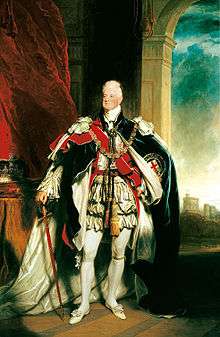Duke of Clarence
Duke of Clarence is a title which has been traditionally awarded to junior members of the British Royal family. All three creations were in the Peerage of England.
The title was first granted to Lionel of Antwerp, the second son of King Edward III, in 1362. Since he died without sons, the title became extinct. The title was again created in favour of Thomas of Lancaster, the second son of King Henry IV, in 1412. Upon his death, too, the title became extinct. The last creation in the Peerage of England was for George Plantagenet, brother of King Edward IV, in 1461. The Duke forfeited his title in 1478, after he had been convicted of treason against his brother. He allegedly met his end (according to William Shakespeare) by being drowned in a butt of Malmsey.
A fourth creation in England was suggested and planned to take effect; the title of Duke of Clarence was going to be given to Lord Guilford Dudley, husband of Lady Jane Grey, upon her coronation, as she declined to make her husband king consort. However, she was deposed before this could take effect.
Two double dukedoms, of Clarence and St Andrews and of Clarence and Avondale were later created for British royal princes. The title also took the form of an earldom for Queen Victoria's son Prince Leopold, Duke of Albany and his son Prince Charles Edward, the Clarence earldom being a subsidiary title.
The title is said to originate[1] from the town of Clare, Suffolk, which was owned by the first duke of Clarence, Lionel of Antwerp. His wife, Elizabeth de Burgh, 4th Countess of Ulster, was a direct descendant of the previous owners, the de Clares, and the Manor of Clare was among the lands which she brought to her husband.[2] After the Union of the Crowns in 1603, the holders of the title were also given titles including Scottish place names: St Andrews and Avondale.
Dukes of Clarence, first Creation (1362)
- also Earl of Ulster (1264) jure uxoris
- Lionel of Antwerp, 1st Duke of Clarence (1338–1368), third (second surviving) son of Edward III, died without male issue
Dukes of Clarence, second Creation (1412)
- also Earl of Aumale (1412)
- Thomas of Lancaster, 1st Duke of Clarence (1388–1421), second son of Henry IV Bolingbroke, died without male issue
Dukes of Clarence, third Creation (1461)
- also Earl of Warwick and Earl of Salisbury (1472)
- George Plantagenet, 1st Duke of Clarence (1449–1478), third son of Richard Plantagenet, 3rd Duke of York and brother to Edward IV and Richard III, was executed for treason in 1478, at which point all of his honours were forfeit.
- His legitimate male line ended with the death in 1499 of his only son Edward Plantagenet, 17th Earl of Warwick.

Duke of Clarence and St Andrews (1789)
- William IV (1765–1837), who became king in 1830, at which point the title merged with the Crown.
Earls of Clarence (1881)
- The Prince Leopold, 1st Duke of Albany, 1st Earl of Clarence & 1st Baron Arklow (1853–1884), fourth son of Queen Victoria
- Charles Edward, Duke of Saxe-Coburg and Gotha, 2nd Duke of Albany, 2nd Earl of Clarence & 2nd Baron Arklow (1884–1954), posthumous son of the 1st Earl, had his British titles suspended in 1919 for waging war against Britain.
- For heirs to the suspended peerages, see Duke of Albany
Duke of Clarence and Avondale (1890)
Family Tree
References
- ↑ Polydore Vergil, in his Anglica Historia of 1534 (Book XIX.36) dates the Dukedom to 1361 and claims to have rediscovered the lost origins of the name. See also David Hatton, Clare, Suffolk, an account of historical features of the town, its Priory and its Parish Church, 2006, Book 1, p21 ISBN 0-9524242-3-1 It is also available online on the Clare website. However, other writers, e.g., T.A. Trant, Narrative of a Journey Through Greece (London: 1830) p4, trace the title Dux Clarentiae to Clarentia (Glarentza) in the Peloponnese, seat of Matilda of Hainaut (aka Maud, Mahaut), Princess of Achaea from 1313-1318, from whom her cousin Philippa of Hainault might have passed to her son Lionel at least an honorific claim to Achaea.
- ↑
 One or more of the preceding sentences incorporates text from a publication now in the public domain: Chisholm, Hugh, ed. (1911). "Clarence, Dukes of". Encyclopædia Britannica. 6 (11th ed.). Cambridge University Press. pp. 427–428.
One or more of the preceding sentences incorporates text from a publication now in the public domain: Chisholm, Hugh, ed. (1911). "Clarence, Dukes of". Encyclopædia Britannica. 6 (11th ed.). Cambridge University Press. pp. 427–428.